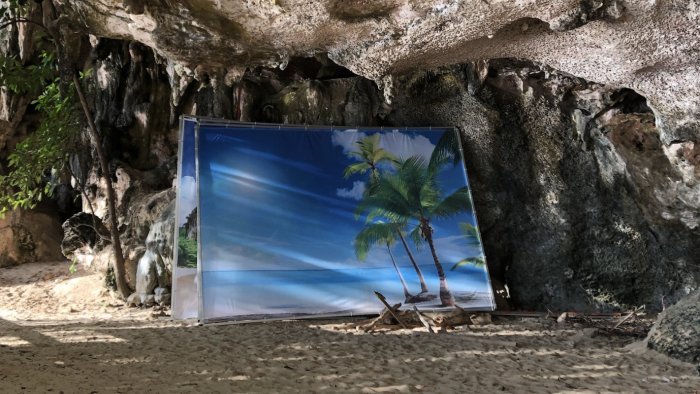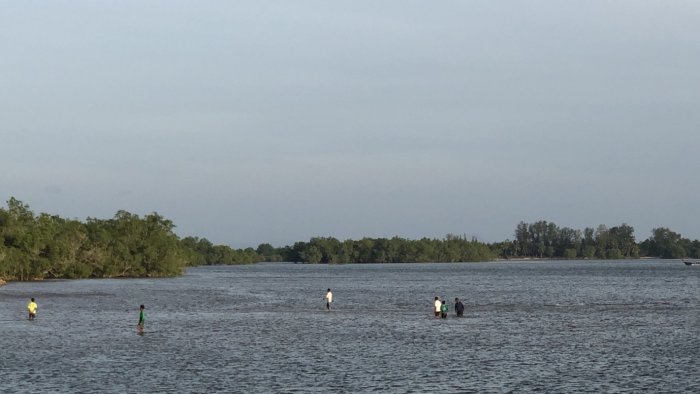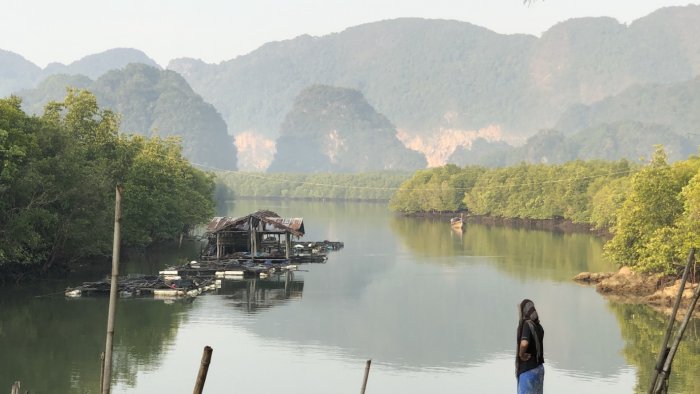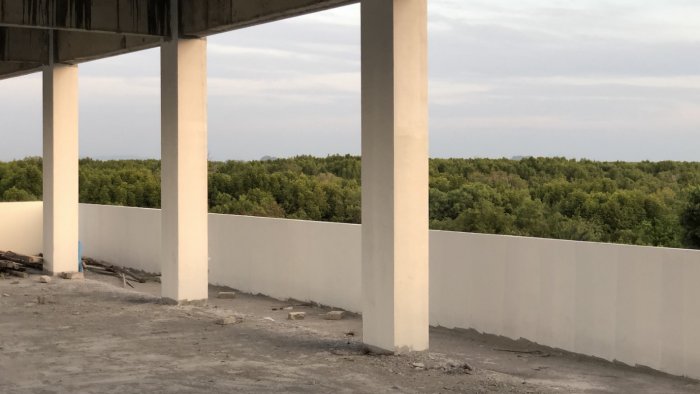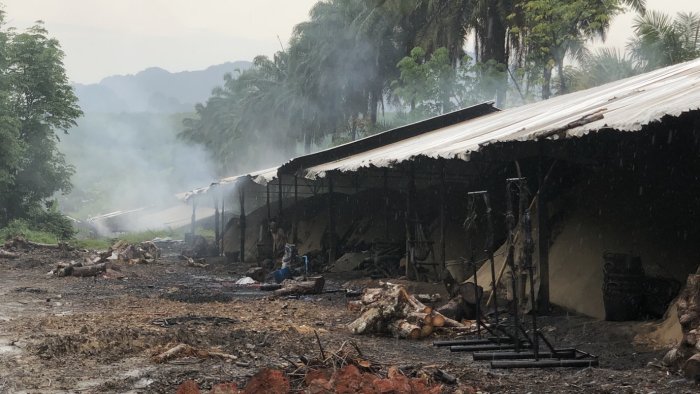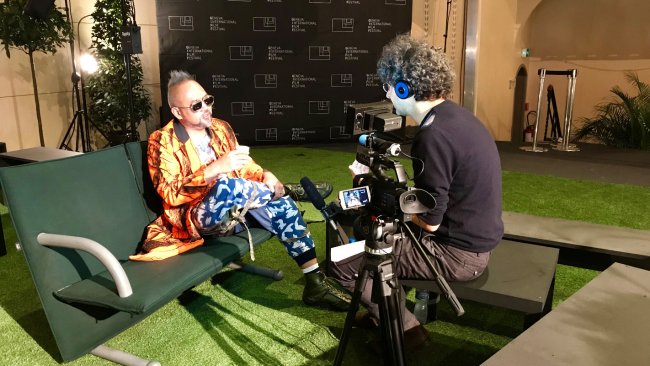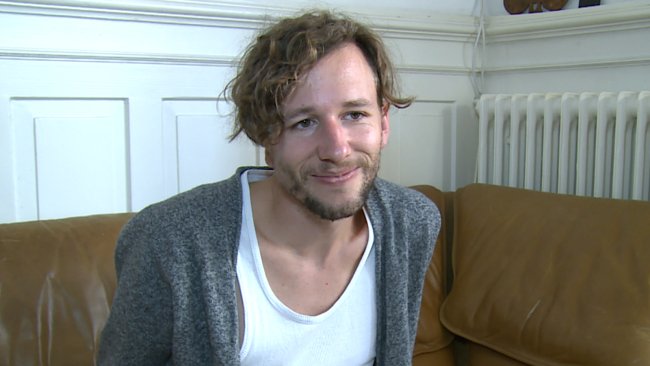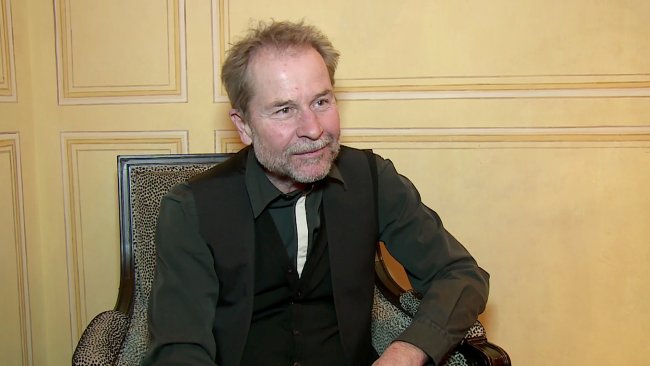Krabi, 2562
[…] The recent history of Thailand is intertwined with contemporary Krabi and, moreover, with pre-historic tales connoting the place. The time of stories and legends prevails on chronology and history and finally converges with the time of film.
[…] «One of the things about making a film without a script is that the editing becomes the place where the story comes together, because it’s more open to the possibility of reshaping the structure, and the work on the sound was absolutely a part of it».
There is a famous tourism destination in Thailand: Krabi. There is a local guide for tourists, but with Krabi, 2562 we don’t really do any “tour”; the circular and predatory attitude of tourism is substituted with the multi-linear and wandering attitude of exploration. The film ventures – and makes us venture – into stories and places that have the flavour of the unknown, in an atmosphere of constant astonishment. This is the result of an elusive narrative style, where details and ellipsis count more than information.
2562 is no more than the current Buddhist year, but this precise indication does not anchor us to a definite now. Ben Rivers and Anocha Suwichakornpong’s film plays with different times. The recent history of Thailand is intertwined with contemporary Krabi and, moreover, with pre-historic tales connoting the place. The time of stories and legends prevails on chronology and history and finally converges with the time of film. We see a film team shooting an advert, thereby making explicit the construction of the time of film. Stories connotate the place, and the location inspires new stories.
Through this circulation of narration and location, we realise that the format of film has the privilege of conveying the invisible into the perceptible reality. In this respect, the pre-historic tales will emerge as the probably most stimulating thread, which echoes in all the indefinite aspects of the film. A film that does not declare but suggests, which does not mean less precision in telling the specificity of Krabi. After having watched Krabi, 2562, we would hardly be able to say something informative on this place, but will have a vivid and unforgettable feeling of its essence.
(Giuseppe Di Salvatore)
*
Interview with Ben Rivers and Anocha Suwichakornpong
Domenico Pedroli (DP): I would start by asking you about the title of the film: “Krabi, 2562”. As I participated in the production of the film, I know that during the phases of funding and production it had a different, equally mysterious, name: “In the Holocene”, and at a certain point it was also named “Krabi Wonderland”. Could you tell me why you found those to be appropriate titles in the first moments and when, during the editing process, did you realise that they didn’t fit the content anymore?
Ben Rivers (BR): We had to come up with a title really quickly for the Thailand Biennale to raise money. At the time I had been in an exhibition called “In the Holocene” which I really liked, and I also liked the sound of the title because it’s kind of mysterious, but at the same time it suggests a bigger geological timespan, not specifically related to contemporary times but to an era that embraces from pre-history to now – but when we edited and showed the rough cut to some friends, we felt that the title wasn’t sitting quite right. Also, the term “Holocene” is now used by in climate discussions as a way of saying that we are still in the Holocene and not in any kind of Anthropocene or whatever you want to call it. We didn’t want any association with this discussion, so we started discussing other titles, and “Krabi Wonderland” was one of those…
Anocha Suwichakornpong (AS): The film also has to do with the idea of Cinema as well; that’s why we thought that it had to deal with magic, but from then on it was clear that the title had to have the word “Krabi” in it, which then turned into “Krabi, 2562”. This is very simple but complex at the same time. It’s the current Buddhist year in Thailand, but anywhere else it sounds science-fictional. It also deals with the concept of time, which we tried to explore in the film where pre-history and the present are coexisting.
DP: Could you share the story of how you ended up working together? Can you talk more about your collaboration?
BR: It had seemed to me like a very obvious and instinctive choice to ask Anocha to collaborate when I was asked to do something in Thailand. It popped into my mind immediately. The reason is that we are good friends and admire the works of the other. There are similarities and differences, and the exciting aspect of it is that you’ll do something that you could never accomplish by yourself. This forces you to be more open, leaving your ego a little bit to the side, and not relying on the comfort zone that we often work within. All this will eventually go in our future projects. (Pause). Our collaboration was really straightforward, we didn’t really have any major argument.
AS: Yes, just some little disagreements, but we didn’t have any sort of clash. Well, you were there, so you know how it went!
BR: The great thing is that, when you do a film by yourself, you feel quite alone. You don’t have anyone to question your decisions. I don’t know about you, Anocha, but sometime I find myself in very undecided situations where I’m not totally sure which way I have to go, but when you are collaborating, you obviously have to figure out together how a scene should be, for example.
AS: I can probably speak on behalf of both, but we are not tyrant directors that believe that there is only one way of doing things. On the contrary, in our practice we often question ourselves whether we are making the right decision while directing. I think that if we are honest with ourselves, we realise that we stumble on that situation quite frequently. So it’s pretty nice to share the decision-making process… and share the blame if it doesn’t work! (laughs).
BR: In the editing, up until the very end, when Ernst Karel, the sound designer, repeats the marching sounds and I was unsure about it, listening to your arguments made me think more carefully and I later realised that it was actually the right decision – which I wouldn’t have come to by myself. That’s a very clear example of how you can sometimes miss something.
DP: The idea of collaboration is very appropriate to me in this case where we went on the set without a screenplay, just a few-pages treatment, because it allows you to have more confidence.
BR: I actually work mostly with treatments because I like to have an idea of the scene and of what I want to happen in it, but at the same time, not having a screenplay allows unexpected things to take place. As a consequence, you have to constantly respond with what you have. You have a vision of a sunny scene but suddenly it’s raining…
AS: I’m also moving towards this way of directing because with By the time it gets dark (Dao Kanong, 2016) I spent three years writing the script and altogether it took six years to make the film. After the film was finished, I was thinking about what to do next. It was clear to me that I didn’t want to work with a standard script. Just some loose scenes. So, working with Ben was a moment in which I could explore this process more.
DP: The Charcoal Factory near Krabi, with its community of roughly 200 people who come from the poorest areas of the country or are illegal immigrants from Myanmar, was a very beautiful location that we scouted various times. It also appears in the short film you did for the Krabi Biennale. Why did you choose to leave it out?
AS: We had a long discussion about it. I felt uncomfortable filming that place because I didn’t know how to represent the place, the community, and how to situate that sequence in the film without spending a certain amount of time there. In other words, we realised that, if we really wanted to have it, we had to spend a longer period there, getting to know them before anything else. There was just not enough time.
BR: I completely agree. I remember that in our final shooting schedule there was just half a day at the Charcoal Factory which is quite the opposite of what I do when I film people in their working environment, in which I stay with them for months! You need time to immerse. (Pause). There was also the problem of the status of the people working and living there, whether they were actually legal or illegal residents… Filming them could have caused serious troubles.
AS: Yeah, that too… We initially had the idea to set a folklore scene and then, at some point, to follow a character, but then we found out that the workers were probably not Thai - so it felt wrong and violating to impose a folklore that wasn’t theirs.
DP: As we all know, mass tourism is quite a recent phenomenon that is actively transforming the landscape, especially in Thailand, soon to become the first economic resource of the country. Some say that it is ruining it. Do you consider it at the centre of your exploration?
BR: It’s funny that you talk about ruining a landscape, because in the film Tarn, the tourist guide mentions the film The Beach (Danny Boyle, 2000), which is famous for ruining and devastating a landscape. So, films can be pretty damaging for a landscape! (laughs) Yet, even if tourism brings hotels all over the place, at the same time it brings also some responsibility, at least to preserve a part of the former landscape so that people can visit it.
AS: I think that Thailand has reached the point of no return, in term of tourism. Nature and no development are not possible anymore. We can’t deny the fact the we, for better or worse, rely on tourism. Tourism changed Krabi and the life of the people, insofar as most of them are somehow involved in tourism. I wouldn’t romanticise the idea of keeping the place as nature created it.
BR: I think that the film is not trying to be judgmental about the humans that are occupying the space.
AS: And it’s not only about Western tourists coming to Krabi. The place itself is a popular destination among locals too. It’s also being used as a cultural site by the Thai government. Reality is not black and white. There are many nuances of how the socio-political aspects intersect.
DP: For me it was very interesting that, in the film, the local kids clearly show how they are influenced by the sightseeing destinations as these are the only places that they know.
BR: Yeah! It is so.
DP: Could you tell more about the editing and the sound design?
BR: One of the things about making a film without a script is that the editing becomes the place where the story comes together, because it’s more open to the possibility of reshaping the structure, and the work on the sound was absolutely a part of it.
AS: I think that the sound is as important as the image. It has its own function, and that is not just to sustain the visual layer. It’s more like a synthesis between the two.
DP: Are you planning to have a screening in Krabi? I remember that at a certain point locals were starting to get very curious about the final outcome. How do you think that it will be received by them?
BR: It’s better not to try to predict how people will react. (laughs) We definitely want to show it there, because we want all the people involved to be able to see it. We should organise an outdoor screening… or screen it in a cave.
AS: It would be great to actually screen it in the cinema with the birds but that’s absolutely not possible. Anyway, there is no way of knowing how the people of Krabi will receive it, but it’s something that we made there, so there might be a sort of connection.
Locarno, 9th August 2019
(Interview: Domenico Pedroli, Locarno Critics Academy 2019)
This article contains a third-party video. If you would like to watch the video, please adjust your settings.
Info
Krabi, 2562 | Film | Ben Rivers, Anocha Suwichakornpong | THA-UK 2019 | 94’ | Locarno Film Festival 2019
First published: August 24, 2019
